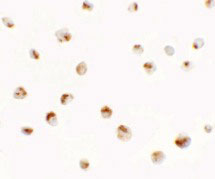SDHD Antibody
- 产品详情
- 实验流程
- 背景知识
Application
| WB, IF, ICC, E |
|---|---|
| Primary Accession | O14521 |
| Other Accession | NP_002993, 4506865 |
| Reactivity | Human, Mouse, Rat |
| Host | Rabbit |
| Clonality | Polyclonal |
| Isotype | IgG |
| Calculated MW | 17043 Da |
| Concentration (mg/ml) | 1 mg/mL |
| Conjugate | Unconjugated |
| Application Notes | SDHD antibody can be used for detection of SDHD by Western blot at 1 - 2 µg/mL. Antibody can also be used for immunocytochemistry starting at 2.5 µg/mL. For immunofluorescence start at 2.5 µg/mL. |
| Gene ID | 6392 |
|---|---|
| Other Names | Succinate dehydrogenase [ubiquinone] cytochrome b small subunit, mitochondrial, CybS, CII-4, QPs3, Succinate dehydrogenase complex subunit D, Succinate-ubiquinone oxidoreductase cytochrome b small subunit, Succinate-ubiquinone reductase membrane anchor subunit, SDHD, SDH4 |
| Target/Specificity | SDHD; At least three isoforms of THBS are known to exist; this antibody will detect all three. |
| Reconstitution & Storage | SDHD antibody can be stored at 4℃ for three months and -20℃, stable for up to one year. As with all antibodies care should be taken to avoid repeated freeze thaw cycles. Antibodies should not be exposed to prolonged high temperatures. |
| Precautions | SDHD Antibody is for research use only and not for use in diagnostic or therapeutic procedures. |
| Name | SDHD |
|---|---|
| Synonyms | SDH4 |
| Function | Membrane-anchoring subunit of succinate dehydrogenase (SDH) that is involved in complex II of the mitochondrial electron transport chain and is responsible for transferring electrons from succinate to ubiquinone (coenzyme Q) (PubMed:10482792, PubMed:9533030). SDH also oxidizes malate to the non-canonical enol form of oxaloacetate, enol- oxaloacetate (By similarity). Enol-oxaloacetate, which is a potent inhibitor of the succinate dehydrogenase activity, is further isomerized into keto-oxaloacetate (By similarity). |
| Cellular Location | Mitochondrion inner membrane; Multi-pass membrane protein |
For Research Use Only. Not For Use In Diagnostic Procedures.
Provided below are standard protocols that you may find useful for product applications.
BACKGROUND
SDHD Antibody: The mitochondrial succinate dehydrogenase complex subunit D (SDHD) is one of four proteins that make up the tricarboxylic cycle enzyme succinate dehydrogenase (SCH). Studies have shown that mutations in SDHD often leads to hereditary paragangliomas, usually benign tumors of the autonomic nervous system, suggesting that SDHD also plays a role as a tumor-suppressor gene. In one family with a nonsense mutation (R22X) in the SDHD gene, a loss of heterozygosity was found in the paragangliomas, and within these tumors the enzymatic activity of Complex II in the mitochondrial respiratory chain was completely abolished. Furthermore, high levels of angiogenic factors EPAS1 and VEGF was observed, which may stimulate tumor growth.
REFERENCES
Baysal BE, Ferrell RE, Willett-Brozick JE, et al. Mutations in SDHD, a mitochondrial complex II gene, in hereditary paraganglioma. Science 2000; 287:848-51.
Saraste M. Oxidative phosphorylation at the fin de siecle. Science 1999; 283:1488-93.
Knudson AG. Genetics of human cancer. Annu. Rev. Genet. 1986; 20:231-51.
Gimenez-Roqueplo AP, Favier J, Rustin P, et al. The R22X mutation of the SDHD gene in hereditary paraganglioma abolishes the enzymatic activity of Complex II in the mitochondrial respiratory chain and activates the hypoxia pathway. Am. J. Hum. Genet. 2001; 69:1186-97.
终于等到您。ABCEPTA(百远生物)抗体产品。
点击下方“我要评价 ”按钮提交您的反馈信息,您的反馈和评价是我们最宝贵的财富之一,
我们将在1-3个工作日内处理您的反馈信息。
如有疑问,联系:0512-88856768 tech-china@abcepta.com.























 癌症的基本特征包括细胞增殖、血管生成、迁移、凋亡逃避机制和细胞永生等。找到癌症发生过程中这些通路的关键标记物和对应的抗体用于检测至关重要。
癌症的基本特征包括细胞增殖、血管生成、迁移、凋亡逃避机制和细胞永生等。找到癌症发生过程中这些通路的关键标记物和对应的抗体用于检测至关重要。 为您推荐一个泛素化位点预测神器——泛素化分析工具,可以为您的蛋白的泛素化位点作出预测和评分。
为您推荐一个泛素化位点预测神器——泛素化分析工具,可以为您的蛋白的泛素化位点作出预测和评分。 细胞自噬受体图形绘图工具为你的蛋白的细胞受体结合位点作出预测和评分,识别结合到自噬通路中的蛋白是非常重要的,便于让我们理解自噬在正常生理、病理过程中的作用,如发育、细胞分化、神经退化性疾病、压力条件下、感染和癌症。
细胞自噬受体图形绘图工具为你的蛋白的细胞受体结合位点作出预测和评分,识别结合到自噬通路中的蛋白是非常重要的,便于让我们理解自噬在正常生理、病理过程中的作用,如发育、细胞分化、神经退化性疾病、压力条件下、感染和癌症。








